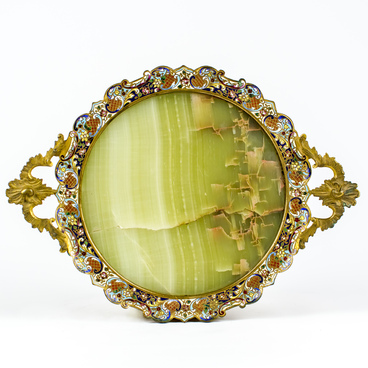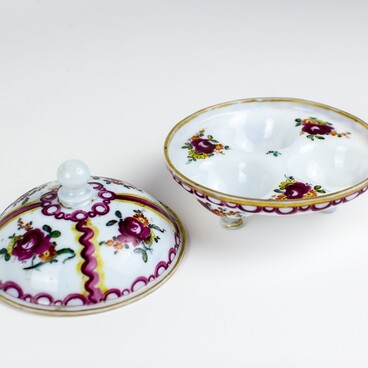The center of the tray with light green margins depicts a scene from Greek mythology called “The Abduction of Europe”. There are handles in the form of holes with a relief gilded design on the sides of the item. There is a trademark of the Vienna Porcelain Factory at the bottom (“Wiener K. u. k. Porzellanmanufaktur). It is an old trademark of the imperial state porcelain manufactory, the so-called Vienna Beehive.
The Vienna Porcelain Factory, which was also called the Imperial Privileged Porcelain Manufactory, was founded in 1718 in Alsergrund, near Vienna. At that time, the main manufacturer of porcelain was a factory in Saxon Meissen. Local craftsmen carefully guarded their production technologies. In those times, porcelain was more expensive than gold in Europe. It was called “precious white gold”. Few specialists knew the secrets of the production of this material. They were called “arcanists"— from the Latin word “arcanum, ” — “mystery”. They were chemical technologists, and all of them worked in Meissen.
However, the Prince-elector of Saxony Claudius du Pacquier found out the recipe for the composition of Meissen porcelain and the technology of its production. He was able, with the help of the imperial ambassador and secret agent Baron Damian Hugo von Wirmont, to lure craftsmen from Meissen to Vienna and in 1718 he created the second porcelain factory in Europe.
Initially, the factory was located outside the city to preserve secrecy. The Imperial Court in Vienna was particularly interested in creating a porcelain manufactory, because they wanted to compete with Chinese products, which were in great demand in Europe. Getting their own porcelain was supposed to contribute to the influx of money into the Austrian treasury.
Therefore, when the manufactory was established, Emperor Charles VI signed a decree on personal protection of the enterprise for 25 years and a monopoly on the production of porcelain on the Habsburg lands. However, the manufactory still could not compete with other porcelain factories both in Europe and abroad. Therefore, in 1863, the unprofitable factory had to be closed by a decision of parliament. The factory resumed its work only in 1923.
The Vienna Porcelain Factory, which was also called the Imperial Privileged Porcelain Manufactory, was founded in 1718 in Alsergrund, near Vienna. At that time, the main manufacturer of porcelain was a factory in Saxon Meissen. Local craftsmen carefully guarded their production technologies. In those times, porcelain was more expensive than gold in Europe. It was called “precious white gold”. Few specialists knew the secrets of the production of this material. They were called “arcanists"— from the Latin word “arcanum, ” — “mystery”. They were chemical technologists, and all of them worked in Meissen.
However, the Prince-elector of Saxony Claudius du Pacquier found out the recipe for the composition of Meissen porcelain and the technology of its production. He was able, with the help of the imperial ambassador and secret agent Baron Damian Hugo von Wirmont, to lure craftsmen from Meissen to Vienna and in 1718 he created the second porcelain factory in Europe.
Initially, the factory was located outside the city to preserve secrecy. The Imperial Court in Vienna was particularly interested in creating a porcelain manufactory, because they wanted to compete with Chinese products, which were in great demand in Europe. Getting their own porcelain was supposed to contribute to the influx of money into the Austrian treasury.
Therefore, when the manufactory was established, Emperor Charles VI signed a decree on personal protection of the enterprise for 25 years and a monopoly on the production of porcelain on the Habsburg lands. However, the manufactory still could not compete with other porcelain factories both in Europe and abroad. Therefore, in 1863, the unprofitable factory had to be closed by a decision of parliament. The factory resumed its work only in 1923.



